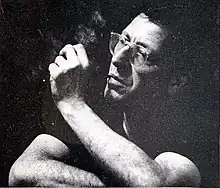The Society I Live in Is Mine
The Society I Live in Is Mine is a 1963 book by Paul Goodman of his accumulated letters to the editor and other public commentary ephemera.
| Author | Paul Goodman |
|---|---|
| Publisher | Horizon Press |
Publication date | April 4, 1963 |
| Pages | 180 |
Contents and themes
"The society in which I live is mine, open to my voice and action, or I do not live there at all."
Paul Goodman[1]
The Society I Live in Is Mine collects social commentary ephemera by Paul Goodman, including letters to the editor, essays, and speeches both published and unpublished in newspapers and magazines. Much of the content is written to address the general public[2] with the intent to urge others to become more alert and intervening citizens by his own example.[3] Goodman describes the collection as "angry letters on public morals and politics"[4] written to "influence the general consensus".[3] He is appalled by how few people self-regard as citizens and instead view society as machinery of authorities in which they participate. Goodman intends to prove that by becoming heard, people can more fully participate in and enjoy their society.[5]
The range of topics covered in his correspondence has no strict categorization[5] but reflects the range of civic problems that interest him.[5] Goodman's general position is that of a "community anarchist": He believes in reducing supreme power (sovereignty), increasing individual initiative, and experimenting in topics such as education and disarmament.[3] Though he writes mostly from a liberal perspective, Goodman makes some arch-conservative points in the name of diminishing sovereignty,[5] notably his position against nation-states and for "personal liberty and local initiative".[1] As one reviewer put it, the collection's only unifying theme is "the mind of Paul Goodman", reflecting his positions as an anarchist and pacifist, and his advocacy for sexual freedom, libertarian education, and face-to-face communication in small communities. His range of positions include: abolishing suburbs,[1] abolishing advertising,[6] rallying civil disobedience and peace marches in response to war,[1] dividing cities into village neighborhoods, offering informal apprenticeships for adolescents, encouraging sex,[6] reducing school administration, and experimenting with small classes and amateur teachers.[7][8]
He spends particular focus on education[4] and the "waste of the young".[9] Goodman advocates for freedom for teachers and students despite living in an era of opposition to progressive schooling.[4] He argues against school standardization as a path to student achievement and believes that American society will be wiser and freer for more greatly distributing the authority to explore personal initiative and make mistakes. In this way, he argues against schools as institutions to contain dropouts and would rather provide them with another way to live decently.[9] Goodman argues against literacy, which he sees as having "no practical importance" in societal decision-making, used mainly to advertise and campaign to individuals.[4]
The book includes many letters to publications and public officials, and some speeches and reviews.[3] His public letters tend towards larger societal problems: to the Federal Communications Commission chair, to a university on advertising, to the New York State Commissioner of Education on good teachers blamed for the bad decisions of administrators, and to the United Nations Secretary General on citizen demonstrations.[5] His proposals are not always pleasing; the text contains notes disclosing where his recipients did not print or acknowledge his letters.[5] Other notes comment on the general effect of the letters.[3] Where his letters went unpublished, Goodman blames the editor's judgment or courage.[1]
Publication

Horizon Press published the book in hardcover on April 4, 1963.[10]
References
- Price 1963.
- Price 1963; The New Yorker 1963.
- Hentoff 1963, p. 54.
- Stanley 1963.
- Hogan 1963.
- The New Yorker 1963.
- Widmer 1980, pp. 83, 163.
- These positions recur in his proposals as a member of Manhattan local school boards.[7][3]
- Hentoff 1963, p. 55.
- Nicely 1979, p. 87.
Bibliography
- Derleth, August (August 8, 1963). "Books of the Times (Revs. of The Society I Live in Is Mine and The Lordly Hudson)". The Capital Times. Madison, Wisconsin. p. 26.
- Hentoff, Nat (July 18, 1963). "A Village Anarchist (Rev. of The Society I Live in Is Mine by Paul Goodman)". Reporter. 29 (2): 54–55.
- Hogan, William (May 18, 1963). "The Letter Writer as a Society-Maker (Rev. of The Society I Live in Is Mine)". Santa Maria Times. Santa Maria, California. p. 31. Also published in "Letters of an Angry Man (Rev. of The Society I Live in Is Mine)". Victoria Advocate. Victoria, Texas. May 26, 1963. p. 28.
- Mintz, Donald (May 24, 1963). "A Book for Today (Rev. of The Society I Live in Is Mine)". Evening Star. Washington, District of Columbia. p. 14.
- Nicely, Tom (1979). Adam and His Work: A Bibliography of Sources by and about Paul Goodman (1911–1972). Metuchen, N.J.: Scarecrow Press. ISBN 978-0-8108-1219-2. OCLC 4832535.
- Pearre, Howell (December 27, 1963). "Essays Cover Variety of Topics". Nashville Banner. Nashville, Tennessee. p. 18.
- Price, Raymond Jr. (May 26, 1963). "On a Soapbox, Proud and Erratic (Rev. of The Society I Live in Is Mine by Paul Goodman)". New York Herald Tribune Books. 39 (27): 11.
- "Rev. of The Society I Live in Is Mine by Paul Goodman". New Yorker. Vol. 39, no. 20. July 6, 1963. p. 74. ISSN 0028-792X.
- Stanley, Donald (April 30, 1963). "Goodman's Anger (Rev. of The Society I Live in Is Mine)". The San Francisco Examiner. San Francisco, California. p. 29.
- Widmer, Kingsley (1980). Paul Goodman. Boston: Twayne. ISBN 0-8057-7292-8.
External links
- Full text at the Internet Archive